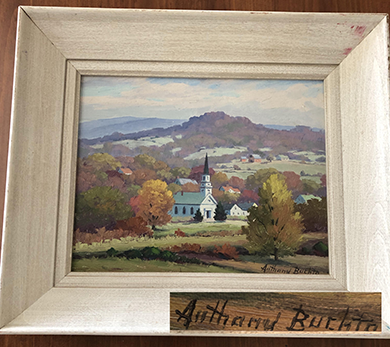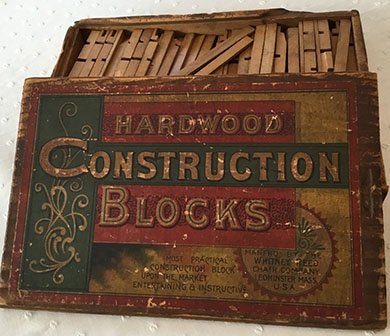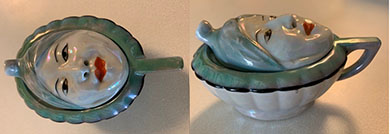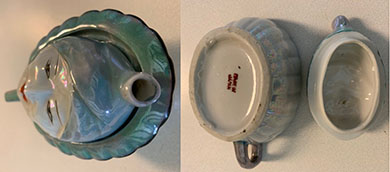 |
|
|||
 |
 |
|||
RINKER ON COLLECTIBLES — Column #1715 Copyright © Harry Rinker, LLC 2019 Questions
and Answers
QUESTION: In cleaning out an estate, I discovered 80 pieces of a child’s artwork in an old postcard album. The geometric approach to many of the pictures appears to resemble that found on Pennsylvania German fraktur. The colored pencil and crayon drawings vary in size. All are smaller than 8-inches by 10-inches. A few are done on scraps. Because they were stored in the postcard album for almost 100 years, the colors are bright and vibrant. Wanessa Platz (1905-1998) of Medina County, Ohio, is the child who drew the pictures. His family moved to Ohio from Meadville, Pennsylvania. The estimated dates for the drawings are between 1910 and 1915. Being child’s artwork, how important are these drawings and do they have monetary and/or intrinsic value? CH, Nashville, TN, Email Question 
ANSWER: The correct secondary market value for the child drawings is curiosity. Child’s artwork is exactly what the term implies—art work done by children. I do not mean to imply there are not talented children’s artists. There are. I have a 13-year old grandson who is one. After examining the illustrations that accompanied your letter, I concluded that these are school drawing exercises, most likely done in the elementary grades. The perspectives for the buildings and other objects are flat, two-dimensional. The drawings probably were inspired by prints and woodcuts found in children’s books. It also is possible the child had access to one or more of the children’s drawing books published by McLoughlin Bros. [Author’s Aside: Fraktur artists were adults, often teachers, who had strong artistic and calligraphy talents. Students often would prepare an illuminated manuscript of a biblical text or hymn as a graduation exercise. Few did more than one example. The Fraktur artists carefully guided their students. Drawing scraps are almost non-existent.] I have a group of similar drawings of the Brewen family farm outside Wind Gap, Pennsylvania, done by Mary Rinker, my grandfather’s sister, when she was in her early teens. Although accomplished, the images still are rather crude. I toyed with the idea of framing some of the drawings and seeing if I could pass them off as American folk art. My ancestor had only minimal art training. I never did it for fear of being successful. Since I expressed my personal opinions about the highly-manipulated folk art market previously, I refrain from revisiting the subject. The question remains as to what to do with the collection of Wanessa Platz’s childhood drawings. First, they should not be broken up. Second, I recommend considering donating them to a historic site featuring a school house in or near Medina County, Ohio, or Meadville, Pennsylvania. Many state farm historical sites include one-room school houses. Third, there are private collectors, albeit few in number, that would buy the collection to protect it. I was tempted to ask the estate sale price but refrained from doing so. My professional ethics do not allow me to buy things about which I write in this column. What is the collection’s curiosity value? If a buyer offered $75.00 to $100.00 for the collection, I advise taking it. Could you get $200.00? Maybe. $250.00 and above is out of the question. QUESTION: I acquired an oil painting by Anthony Buchta, an Indiana artist. The painting features a country church and a few buildings in a mountainous landscape setting. The frame measures 13 1/2-inches by 11 1/2-inches. The painting measures 8-inches by 10-inches. The inscription on the back of the painting reads: “Presented to R. C. Clark on October 1960 by Employees of Eli Lilly& Co. Indianapolis, Indiana on his retirement after 38 years of service October 31, 1960.” I would appreciate any information you provide about the painting and its value. -- BT, IN, Email Question 
ANSWER: Anthony Buchta was born in Cedar Rapids, Iowa, on June 13, 1896. His parents immigrated from Czechoslovakia. Buchta attended the Chicago Academy of Fine Arts for two years followed by additional studies at the Art Institute. In addition to doing studio art, he provided commercial art images to Montgomery Ward and Company and Sears, Roebuck. In between, he studied landscape painting with Charles Schroeder. Eventually, Buchta joined the Palette and Chisel Club. Along with Palette and Chisel Club members C. Curry Bohm, Ericson, and Turtle, Buchta traveled to Brown County, Indiana, in the 1920s. A number of exhibits followed—Chicago Gallery Association, Chicago Painters and Sculptures, the Brown County Art Guild, the Hoosier Salon, the Joliet Artist League, the North Shore Art Guide, and the Scarab Club of Detroit. Buchta died on December 22, 1967 in Columbus, Indiana. Anthony Buchta is one of thousands of “local” artists whose collectability and value is limited to a narrowly defined region, in this case, Indiana, Illinois, Iowa, and Missouri. Outside this area, there is limited interest in his work. The good news is there are several Indianapolis private collectors and galleries that are eager to purchase Buchta’s works, especially if Indiana focused. Askart.com and WorthPoint.com list several dozen Anthony Buchta paintings that have been offered for sale over the past three years. Several key auctions and galleries sell his work—Eldred’s, Jackson Auctions, and Wickliff & Associates. The sell through rate is high with most paintings selling within estimates. Buchta was extremely prolific, emphasizing sweeping landscapes as opposed to more limited scenes such as the example you own. Since he worked in watercolor and oils, care is required when evaluating prices to make certain that comparable examples match. It is apparent that Buchta had good, okay, and bad days when his paintings are judged aesthetically. On a scale of one (lowest) to ten (highest) in terms of aesthetic quality, your landscape is between a 6 and 7. The value of your painting depends upon where it is offered for sale. If sold in the Indianapolis market, a reasonable estimate is $750.00 to $900.00. If sold outside Buchta’s Midwest secondary market, it will bring less. QUESTION: I have a wooden boxed set of “HARDWOOD CONSTRUCTION BLOCKS” made by the Whitney and Reed Chair Company, Leominster, Massachusetts. The label on the box lid notes “MOST PRACTICAL / CONSTRUCTION BLOCK / UPON THE MARKET / ENTERTAINING & INSTRUCTIONAL.” I found them in my grandfather’s family home. When were they made and what is their value? – JJ, Brevard, NC 
ANSWER: The Whitney Reed Chair Company, founded in 1893, made not only high-quality furniture but also rocking horses and wooden toys such as alphabet blocks. The Whitney Reed Chair Company merged with the W. S. Reed Toy company in 1899 after fire destroyed the latter’s factory in 1896. Both companies produced talking (Ouija) boards before the merger. The name Whitney Reed Chair Company was retained after the merger. Construction block sets were popular children’s toys during the last quarter of the Victorian era until the beginning of World War I. The most popular were Anchor stone block sets made in Rudolstadt, Germany, and imported into the United States. American toy manufacturers used wood for their construction sets. Completeness is a major issue regarding your construction set. It came without a list of parts. The safest approach is to assume some are missing. Your set dates prior to 1915. Much of the value rests in the paper label, which appears to be in good to very good condition. On the upside, your construction set has a value between $125.00 and $150.00. On the downside, its value is between $50.00 and $65.00. The key is to find the buyer who will pay the higher price. It is a difficult task under the best of circumstances. QUESTION: I purchased a “What’s it” and have tried my best to figure out what it is. The object has an oval shaped base with a handle. The lid is a relief face of a woman with a spout extending out through her hair. The piece is marked “Made in Japan” and measures about 5-inches long and 2 3/4-inches high. There is no rim to prevent the top from sliding off. My best guess is its some type of neti pot or inhaler. – KT, Winter Haven, FL, Email Question 
ANSWER: If it is an inhaler, how does the liquid inside stay hot enough to give off a vapor? It certainly is not an infant or invalid feeder nor a nasal douche. Honestly, I am stumped. Hopefully, a “Rinker on Collectibles” reader can identify its use. If so, send an email to me at harrylrinker@aol.com and let me know. I will pass along the solution to the person who inquired as well as my readers. 
Harry L. Rinker welcomes questions from readers about
collectibles, those mass-produced items from the twentieth and twenty-first centuries.
Selected letters will be answered in this column.
Harry cannot provide personal answers.
Photos and other material submitted cannot be
returned.
Send your questions to: Rinker on Collectibles, 5955 Mill
Point Court SE, Kentwood, MI 49512.
You also can e-mail your questions to
harrylrinker@aol.com.
Only e-mails containing a full name and mailing address
will be considered.
|
||||